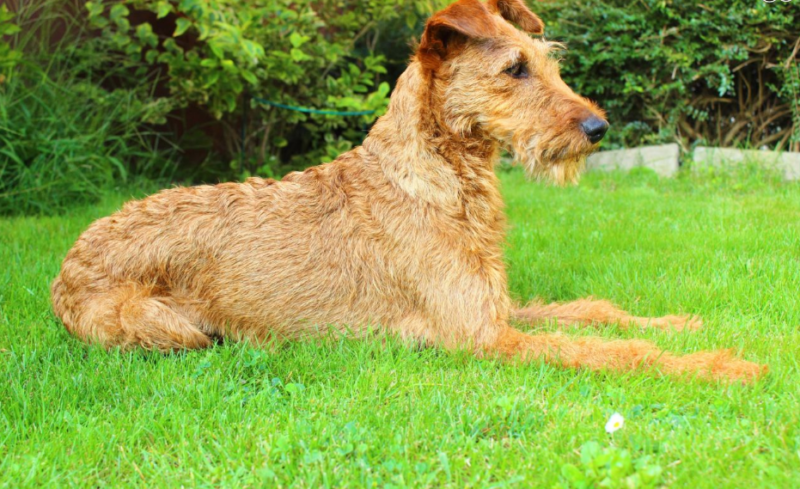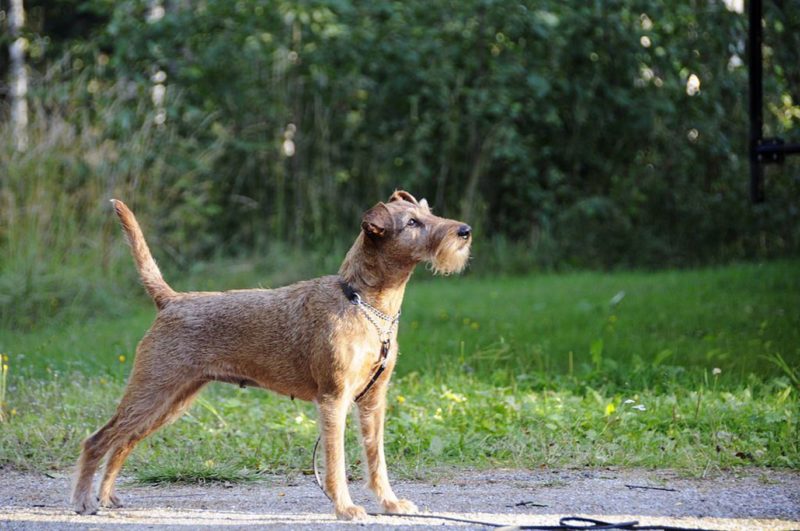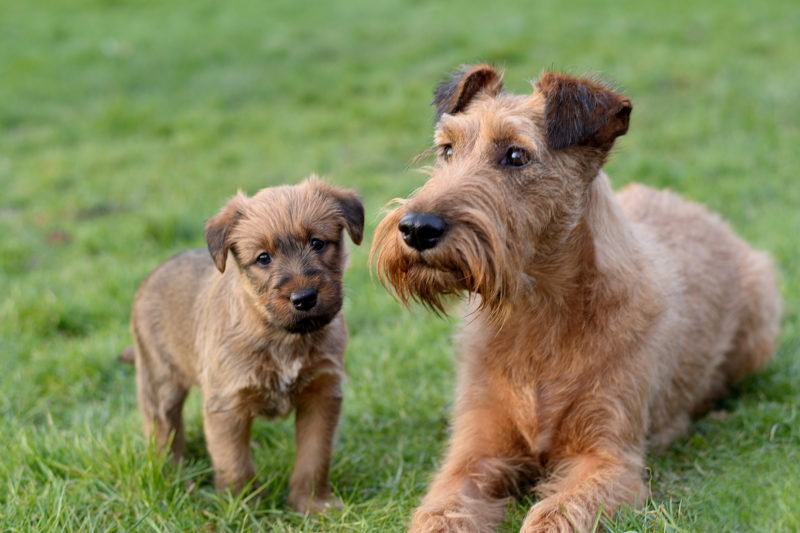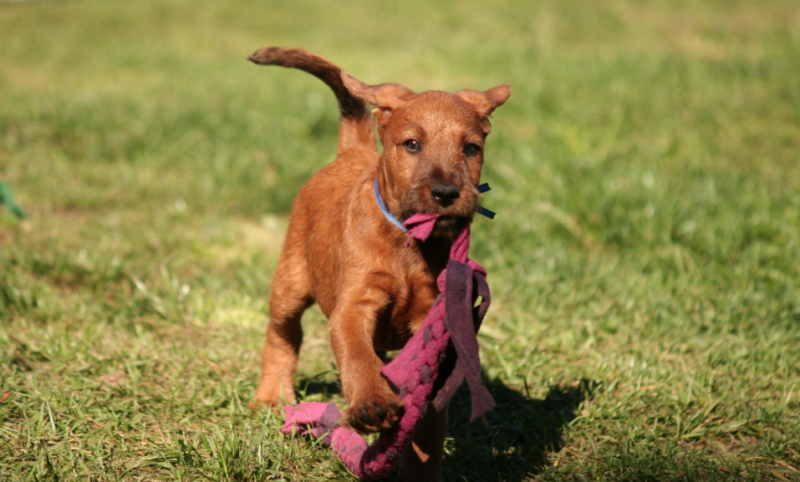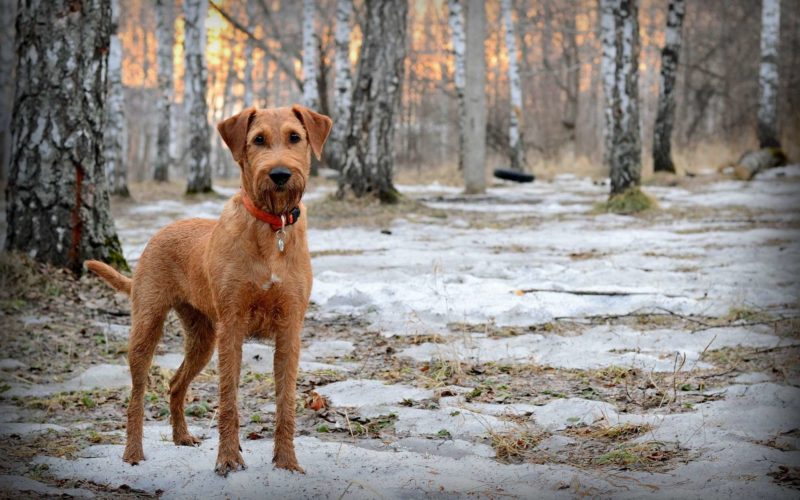Acquainted with representatives of a breed called the Irish Terrier, Jack London wrote: "The Irishman is an honest dog who does not hide his essence under the length of his hair." This excellent characteristic causes a desire to get to know the dog, its history and features of the content.
Material Content:
Description of the breed Irish Terrier
Irish terriers are well suited as companions for large families. They are always ready to participate in children's games, love communication. These are quite large dogs, slender, with a tucked up stomach, harmoniously built and muscular.
A distinctive feature of their appearance is a short red hair, like Irish hair, and a funny beard on the face. The movements of the terrier are quick and agile, he shows a desire for leadership in communicating with other dogs. Friendly to people, but can not stand rough treatment.
Origin history
Images of Irish terriers were found on the canvases of the masters of the XVIII century, but the first breed standard was adopted only after 100 years. It described the articles of a nimble and fearless hunter, who is easy to get a quick-footed hare, drive a fox, meet a badger and compete with a wild boar.
In Ireland, the breed was officially recognized in 1870, and acquired its modern appearance only at the end of the 19th century.
Its first representatives were distinguished by a variety of stripes and species; the coat could be brown, black or white. The club of admirers of the breed, created in the 79th year of the XIX century, took control of dog breeding.Dog handlers began to organize exhibitions, selecting the best representatives for posterity. The breed has earned well-deserved recognition around the world.
The purpose and nature of the dog
It is sometimes said about this dog that she is a watchman for the poor, a friend of the farmer and the favorite of the master. So it is - the Irish Terrier will not let strangers on the threshold, the farm will save it from rats and mice and will not return from hunting without a trophy. These dogs are not afraid of gun shots and follow the trail perfectly. The first irish fell into Russia after the end of World War II. The breed immediately found fans among the dog breeders. Although today the working qualities are not forgotten and not lost, more often these dogs are bred as pets and companions.
Irish terriers - dogs are quite curious, will not pass by if they are interested in something, they love children very much. They have a cheerful and open character, compact size, non-shedding wool. They are like people, they have each their own disposition, and show it already in puppyhood. Someone is born a leader, someone likes to eat, sleep or play.
Breed standard
The Irish Terrier is an active and lively dog of strong build. Of great importance is the harmonious development of all parts of the body, the ability to run fast and endurance.
Description of the breed:
- the head is long;
- the skull is flat;
- eyes are dark, with a lively, intelligent expression;
- ears in the form of small triangles hang forward;
- neck of medium length without suspension;
- the back is strong and even;
- the chest is deep, muscular, but not wide;
- tail set high;
- paws are moderately long, strong;
- the coat is thick, wire-like with a kink;
- solid color, from bright red to yellow-red;
- growth at the withers - about 45 cm;
- Irish Terrier weight - up to 12 kg.
Red-wheat, yellow-red and red color with small white spots on the chest or fingers is allowed.
Criteria for choosing a puppy and his upbringing
Before choosing a puppy, you need to study the breed well - to find out its nature and content features. Then find a decent breeder who enjoys a good reputation. The best dogs can be seen at the exhibition to get a true picture of the breed and learn about the upcoming breeds.
You can see the future pet when it turns one month old, pick it up a little later, after the first vaccinations. Having gone to the kennel, it is advisable to see how the puppies of the Irish Terrier live, to communicate with the breeder. Be sure to get acquainted with the puppy's parents, because not only looks, but also character is inherited.
If you need a dog for exhibitions, it is better to invite a specialist canine specialist who knows the breed well. It will help to choose not only a healthy, but also a promising animal, with good exterior data.
When a dog is bought for the soul, not thinking about breeding and exhibitions, the choice is made in favor of a healthy baby, active and causing the greatest sympathy. In a family with children choose a contact puppy who loves to play.
As soon as a small dog crosses the threshold of a new home, it will require a lot of attention, warmth and care. Proper education will be the key to a strong friendship between the terrier and the owner. The most successful training for teams and prohibitions in puppies takes up to 6 months. In puppyhood, heavy loads, a long run, jumping or long walks are contraindicated, but the foundations of education are laid in the first months of life.
The dog must have its own toys. You need to play with her, explain who is in charge of the house, and teach obedience. So that there is no problem with an adult pet, it is imperative to accustom the puppy to hygienic procedures - brushing his ears and teeth, rubbing his eyes, and cutting his nails.
Pet Care
Caring for a dog is simple, it does not fade when the hair dies, it must be removed mechanically. Hygienic trimming of the Irish Terrier is done 2 times a year, bathed no more than 1 time in 3 months.Properly placed ears are an important sign of thoroughbred, you need to monitor it, using the help of specialists.
When kept in the city, the dog needs to be walked for at least 2 hours a day so that she can run without a leash. In the countryside, it is necessary to keep the Irish terrier in the house, he will be able to participate in all matters, be a companion of the owner. Without human attention, the dog will suffer, so contact must be constant.
It is important for the dog to provide good nutrition by choosing a natural diet or premium dry food. Do not mix dry food and ordinary foods in one meal.
The menu should include raw meat (anything except pork), cereals, vegetables, fruits, herbs, eggs, dairy products, fish.
Do not feed the dog:
- spices
- onions;
- baking and sweets;
- sausage;
- fried, smoked, salty foods;
- grapes and chocolate.
You can also not give a lot of potatoes, beans and bread.
The number of meals depends on the age of the animal - the puppy is fed 4 times a day until six months, and an adult dog - 1 - 2 times. Food should be given after a walk, training, training. With a full stomach, the dog rests so that the intestines do not turn over. Always have clean drinking water in the bowl.
When to start walking and training
Almost all terriers are mischievous and stubborn, and they need a certain approach. The Irish Terrier needs to be educated, and not trained from the first days of his stay in the house (age 7 - 17 weeks). Training in the usual sense of the word for a dog of this breed is too boring. Certain terrier skills are easier to learn while playing and walking outdoors.
You can take the puppy out 2 weeks after revaccination.
The Irishman is happy when he is on the move, he likes to walk for a long time, catch new smells and discover the world, make acquaintance and enjoy communicating with his own kind. As friends, terriers choose the same active and funny, regardless of size and weight category. They will feel on an equal footing with any member of the canine tribe. The Irish do not recognize authority, and in the heat of excitement they can run into trouble. Despite their hot Irish blood, terriers are very charming.
There is an opinion that the Irish Terrier dog is inclined to sort things out with his relatives. Initially, all puppies are good-natured, and love to play with each other, but the inborn sociability and good nature of the dog must be maintained. In relations with the pet, dog handlers advise finding a middle ground - to educate, but not pamper.
Pros and Cons of the Irish Terrier
Irish Terriers have a hard time finding flaws. Loyal defenders, faithful helpers and companions, friends for fun games - these dogs conquer with their vitality and energy.
They are perfect for life in the city, their fur does not fade, it requires simple maintenance.
Only with improper upbringing can there be problems with other animals. Terriers need sufficient physical activity for good health and mood, so you should not start a breed for people with limited time or active movement.


